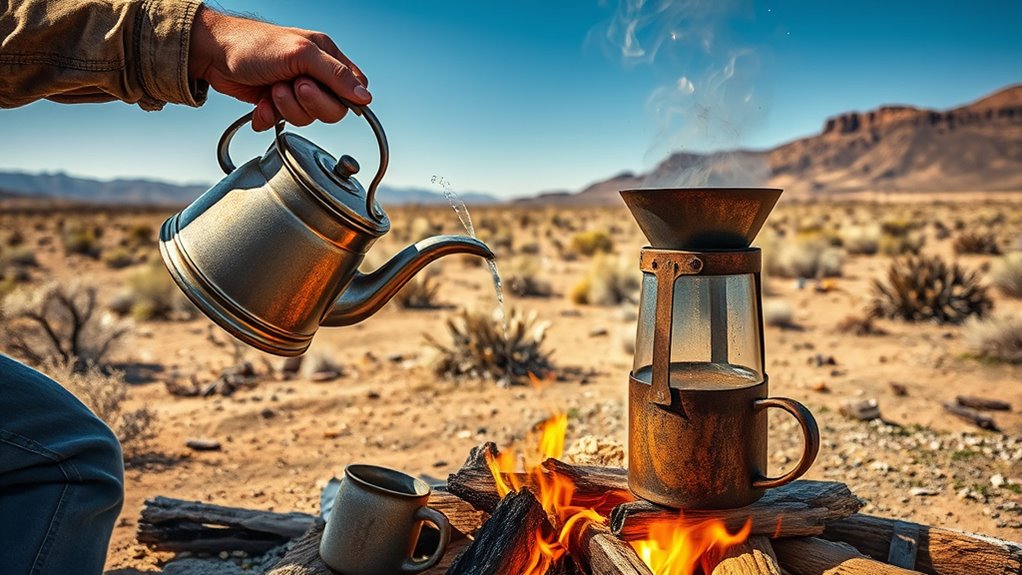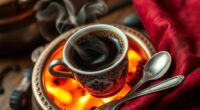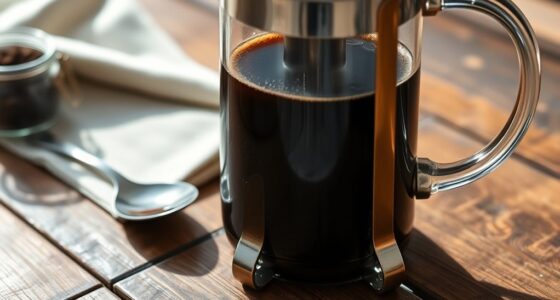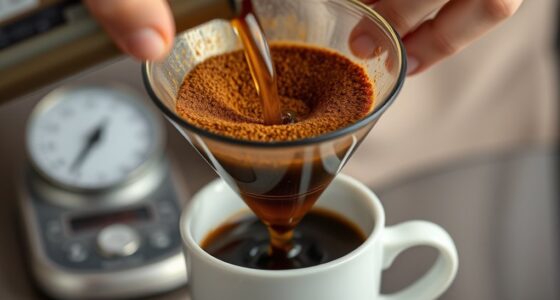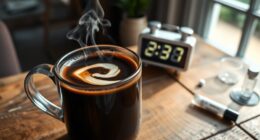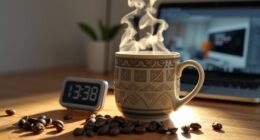You can brew flavorful coffee without a machine by trying methods like cowboy coffee, which involves boiling coarsely ground beans directly in water and letting it steep briefly. Keep the water just below boiling to avoid bitterness, and use a strainer or cloth filter to catch grounds before serving. experimenting with beans and steeping times helps customize your brew. If you keep exploring, you’ll discover even more simple ways to craft great coffee on your own.
Key Takeaways
- Cowboy coffee involves boiling coarsely ground beans directly in water without special equipment.
- Use fresh, high-quality beans and adjust roast type for desired flavor profiles.
- Control temperature by bringing water just to a boil, then remove from heat before pouring over grounds.
- Filter the brew with a cloth or metal strainer to reduce grit and improve clarity.
- Experiment with steeping time and bean varieties to customize strength and flavor in DIY coffee.
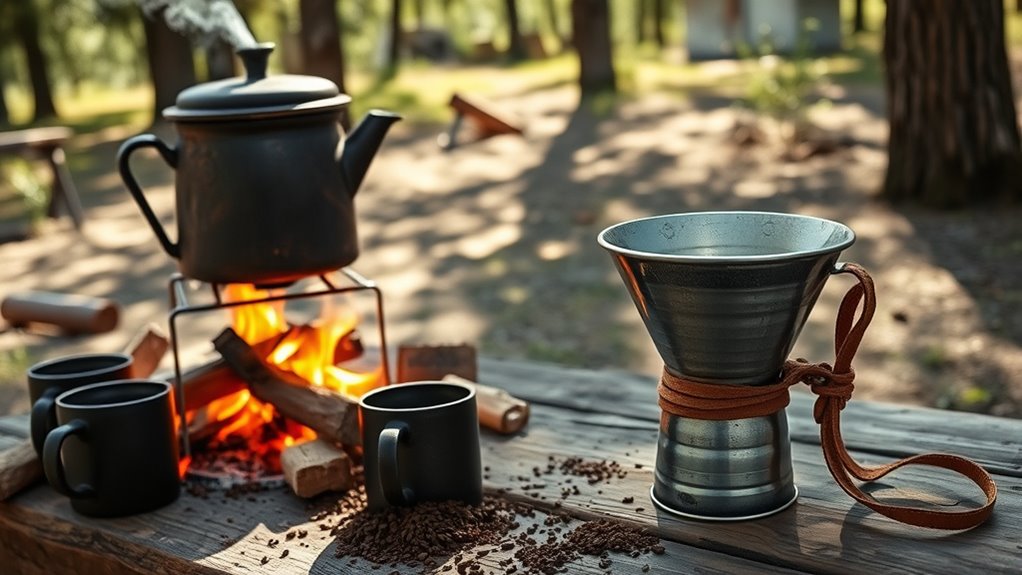
Making your own coffee at home can be both simple and rewarding, especially if you enjoy experimenting with different brewing methods. When you’re trying to brew without a machine, the key is understanding how to maximize flavor using simple tools. One of the most traditional methods is cowboy coffee, which involves boiling coffee grounds directly in water. This technique requires no fancy equipment—just a pot, some coffee bean varieties, and a bit of patience. The choice of coffee bean varieties impacts the final taste, so selecting fresh, high-quality beans suited to your flavor preferences makes a big difference. Dark roasts bring bold, robust flavors, while lighter roasts offer brighter, more nuanced notes. Once you’ve chosen your beans, grind them coarsely; fine grounds tend to slip through the strainer and make the coffee gritty.
When brewing cowboy coffee, controlling the brewing temperature is essential. You want to bring the water just to a boil, then remove it from the heat before pouring over the grounds. Overly high temperatures can extract bitter compounds and muddy the flavor, so patience and attention to temperature control really matter. After pouring hot water over the grounds, allow the mixture to steep for a few minutes, giving the flavors time to develop. When it’s ready, carefully pour the coffee into your mug, leaving the grounds behind in the pot. This method produces a rich, full-bodied brew, but it’s also forgiving enough for beginners to try at home. Using the right brewing techniques can help you achieve an even better flavor profile.
If you prefer a less gritty experience, you can use a simple cloth or metal strainer to filter out the grounds. This makes the process more manageable and results in a cleaner cup. The key to success with DIY methods like cowboy coffee is understanding how brewing temperature control influences extraction. Too hot, and you risk bitterness; too cool, and the flavors won’t fully develop. Experimenting with different coffee bean varieties also lets you customize your brew to your taste. For the best results, keep your water just below boiling when pouring over the grounds, and let it steep for a few minutes. This way, you maximize flavor extraction while avoiding over-extraction that can ruin the taste.
Frequently Asked Questions
Can Cowboy Coffee Be Made With Any Coffee Roast?
You can make cowboy coffee with any coffee roast, but your best options depend on your taste preferences. Dark roasts offer a bold flavor, while lighter roasts bring out more nuanced notes. Keep in mind the coffee bean origin, as it influences flavor. Use a coarse grind size to prevent over-extraction and sediment in your brew. Adjust based on your desired strength and flavor profile for a satisfying cup.
How Long Should I Boil Coffee for Optimal Flavor?
Boiling coffee is like brewing a storm—timing is everything. For ideal flavor, you should boil your coffee for about 4 to 5 minutes, stirring occasionally. Use a coarse coffee grind to prevent over-extraction. Keep an eye on the boiling time; too long and it’ll turn bitter, too short and you’ll miss out on richness. Adjust based on your taste, but don’t go beyond 5 minutes for the best results.
Is Cowboy Coffee Suitable for Cold Brewing?
Cowboy coffee isn’t ideal for cold brewing because it’s brewed with a coarse coffee grind and a hot brewing vessel, which helps extract flavors quickly. Cold brewing needs a fine coffee grind and a sealed container to steep slowly in cold water for 12-24 hours. Using cowboy coffee methods for cold brewing won’t give you the smooth, low-acid flavor you want. Stick to cold brew techniques for the best results.
What Is the Best Type of Water to Use?
You might think any water works, but the best type for brewing cowboy coffee is filtered water with balanced mineral content. Investigations show that water filtration removes impurities, enhancing flavor, while minerals like calcium and magnesium improve extraction. Using hard water with excess minerals can cause bitterness, so aim for filtered water with moderate mineral levels. This guarantees a smooth, rich brew that truly highlights your coffee’s natural flavors.
How Do I Prevent Coffee Grounds From Spilling?
To prevent coffee grounds from spilling, you should use filtering techniques that improve ground retention, like a makeshift cloth or a fine mesh filter. Before pouring, make certain your filter is securely placed, and avoid overfilling your container. Stir gently to settle grounds, and pour slowly. This helps keep grounds contained, minimizes spills, and results in a cleaner brew. Proper filtering techniques make your DIY coffee experience smoother and more enjoyable.
Conclusion
Now that you know how to brew coffee without a machine, you’re ready to embrace the simplicity and flavor of cowboy coffee or other DIY methods. Imagine Sarah, a hiker who started making her coffee over a campfire, discovering richer, bolder tastes. With just a pot and fresh grounds, you can enjoy a satisfying brew anywhere. So go ahead—grab your favorite beans and start experimenting. Your perfect cup is just a DIY step away!
